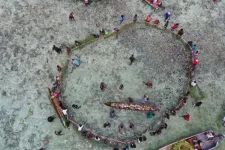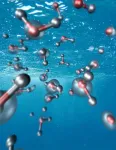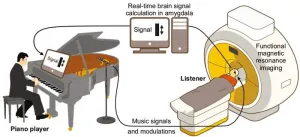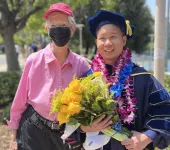(Press-News.org) Human coexistence depends on cooperation. Individuals have different motivations and reasons to collaborate, resulting in social dilemmas, such as the well-known prisoner's dilemma. Scientists from the Chatterjee group at the Institute of Science and Technology Austria (ISTA) now present a new mathematical principle that helps to understand the cooperation of individuals with different characteristics. The results, published in PNAS, can be applied to economics or behavioral studies.
A group of neighbors shares a driveway. Following a heavy snowstorm, the entire driveway is covered in snow, requiring clearance for daily activities. The neighbors have to collaborate. If they all put on their down jackets, grab their snow shovels, and start digging, the road will be free in a very short amount of time. If only one or a few of them take the initiative, the task becomes more time-consuming and labor-intensive. Assuming nobody does it, the driveway will stay covered in snow. How can the neighbors overcome this dilemma and cooperate in their shared interests?
Scientists in the Chatterjee group at the Institute of Science and Technology Austria (ISTA) deal with cooperative questions like that on a regular basis. They use game theory to lay the mathematical foundation for decision-making in such social dilemmas. The group’s latest publication delves into the interactions between different types of individuals in a public goods game. Their new model, published in PNAS, explores how resources should be allocated for the best overall well-being and how cooperation can be maintained.
The game of public goods
For decades, the public goods game has been a proven method to model social dilemmas. In this setting, participants decide how much of their own resources they wish to contribute for the benefit of the entire group. Most existing studies considered homogeneous individuals, assuming that they do not differ in their motivations and other characteristics. “In the real world, that’s not always the case,” says Krishnendu Chatterjee. To account for this, Valentin Hübner, a PhD student, Christian Hilbe, and Maria Kleshina, both former members of the Chatterjee group, started modeling settings with diverse individuals. A recent analysis of social dilemmas among unequals, published in 2019, marked the foundation for their work, which now presents a more general model, even allowing multi-player interaction.
“The public good in our game can be anything, such as environmental protection or combating climate change, to which everybody can contribute,” Hübner explains. The players have different levels of skills. In public goods games, skills typically refer to productivity. “It’s the ability to contribute to a particular task,” Hübner continues. Resources, technically called endowment or wealth, on the other hand, refer to the actual things that participants contribute to the common good.
In the snowy driveway scenario, the neighbors vary significantly in their available resources and in their abilities to use them. Solving the problem requires them to cooperate. But what role does their inequality play in such a dilemma?
The two sides of inequality
Hübner’s new model provides answers to this question. Intuitively, it proposes that for diverse individuals to sustain cooperation, a more equal distribution of resources is necessary. Surprisingly, more equality does not lead to maximum general welfare. To reach this, the resources should be allocated to more skilled individuals, resulting in a slightly uneven distribution. “Efficiency benefits from unequal endowment, while robustness always benefits from equal endowment,” says Hübner. Put simply, for accomplishing a task, resources should be distributed almost evenly. Yet, if efficiency is the goal, resources should be in the hands of those more willing to participate—but only to a certain extent.
What is more important—cooperation efficiency or stability? The scientists’ further simulations of learning processes suggest that individuals balance the trade-off between these two things. Whether this is also the case in the real world remains to be seen. Numerous interpersonal nuances also contribute to these dynamics, including aspects like reciprocity, morality, and ethical issues, among others.
Hübner’s model solely focuses on cooperation from a mathematical standpoint. Yet, due to its generality, it can be applied to any social dilemma with diverse individuals, like climate change, for instance. Testing the model in the real world and applying it to society are very interesting experimental directions. “I’m quite sure that there will be behavioral experiments benefiting from our work in the future,” says Chatterjee. The study could potentially also be interesting for economics, where the new model’s principles can help to better inform economic systems and policy recommendations.
END
What math tells us about social dilemmas
Scientists at ISTA present a new mathematic model for cooperation
2024-02-26
ELSE PRESS RELEASES FROM THIS DATE:
Protecting fish doesn’t have to mean neglecting people, study concludes
2024-02-26
BEAUFORT, N.C. –With fish stocks declining globally, more than 190 countries recently made a commitment to protect about a third of the world’s oceans within “Marine Protected Areas,” or MPAs by the year 2030. But these designated areas of the ocean where fishing is either regulated or outright banned can come at a huge cost to some coastal communities, according to a new analysis.
To help prepare for the expansion of MPAs, an international team of researchers from Duke University, Florida State ...
What will it take for China to reach carbon neutrality by 2060?
2024-02-26
To become carbon neutral by 2060, as mandated by President Xi Jinping, China will have to build eight to 10 times more wind and solar power installations than existed in 2022. Reaching carbon neutrality will also require major construction of transmission lines.
China land use policies will also have to be more coordinated and focused on a nation-wide scale rather than be left to ad hoc decisions by local governments. That’s because 80% of solar power and 55% of wind power will have to be built within 100 miles of major population centers.
These are the conclusions of a new study from ...
A new theoretical development clarifies water's electronic structure
2024-02-26
There is no doubt that water is significant. Without it, life would never have begun, let alone continue today – not to mention its role in the environment itself, with oceans covering over 70% of Earth.
But despite its ubiquity, liquid water features some electronic intricacies that have long puzzled scientists in chemistry, physics, and technology. For example, the electron affinity, i.e. the energy stabilization undergone by a free electron when captured by water, has remained poorly characterized from an experimental ...
Live music emotionally moves us more than streamed music
2024-02-26
How does listening to live music affect the emotional center of our brain? A study carried out at the University of Zurich has found that live performances trigger a stronger emotional response than listening to music from a device. Concerts connect performers with their audience, which may also have to with evolutionary factors.
Music can have a strong effect on our emotions. Studies have shown that listening to recorded music stimulates emotional and imaginative processes in our brain. But what happens when we listen to music in a live setting, for example at a music festival, at the opera or a folk concert? ...
Detroit research team to develop novel strategies to identify genetic contributions to cancer risk and overcome barriers to genetic testing for African Americans
2024-02-26
DETROIT – A team of researchers from Wayne State University and the Barbara Ann Karmanos Cancer Institute has received a five-year, $9.6 million grant from the National Cancer Institute of the National Institutes of Health for the study “Genetic Variation in Cancer Risk and Outcomes in African Americans.” This is a Program Project Grant that includes three large studies. The team will work to improve the identification and clinical management of hereditary and multiple primary cancers in African Americans, a population that is currently underrepresented in genetic research.
According to Ann Schwartz, Ph.D., principal investigator of the project, professor and ...
Vaping can increase susceptibility to infection by SARS-CoV-2
2024-02-26
RIVERSIDE, Calif. -- Vapers are susceptible to infection by SARS-CoV-2, the virus that spreads COVID-19 and continues to infect people around the world, a University of California, Riverside, study has found.
The liquid used in electronic cigarettes, called e-liquid, typically contains nicotine, propylene glycol, vegetable glycerin, and flavor chemicals. The researchers found propylene glycol/vegetable glycerin alone or along with nicotine enhanced COVID-19 infection through different mechanisms.
Study results appear in the American Journal of Physiology.
The researchers ...
Dissecting the roles for excitatory and inhibitory neurons in STXBP1 encephalopathy
2024-02-26
A recent study from Baylor College of Medicine and Texas Children’s Hospital has discovered inhibitory and excitatory neurons play distinct roles in the pathogenesis of STXBP1 encephalopathy, one of the top five causes of pediatric epilepsies and among the most frequent causes of neurodevelopmental disorders. This early-onset disorder is caused by spontaneous mutations in the syntaxin-binding protein 1 (STXBP1) gene. While STXBP1 gene variants impair both excitatory and inhibitory neurotransmission, this study led by Dr. Mingshan Xue, associate professor at Baylor and principal investigator at the Jan and Dan Duncan Neurological Research Institute (Duncan ...
Boston College biologist awarded $2.5-million NIH grant to explore the role of viral insulins and potential applications to cancers
2024-02-26
Chestnut Hill, Mass (2/26/2024) – Boston College Assistant Professor of Biology Emrah Altindis has been awarded a five-year, $2.5-million grant from the National Institutes of Health to study viral insulins and mechanisms related to IGF-1 receptor protein inhibition and its potential applications in cancer treatment.
Altindis said he and the researchers in his lab will use the grant to learn more about how to use specific viral insulins – particularly insulin-like growth factor-1 (IGF-1) – to inhibit IGF-1 receptor action, which is increased in a range ...
New clinical practice guideline provides evidence-based recommendations for immunotherapy for inhalant allergy
2024-02-26
ALEXANDRIA, VA —The American Academy of Otolaryngology–Head and Neck Surgery Foundation published the Clinical Practice Guideline: Immunotherapy for Inhalant Allergy today in Otolaryngology–Head and Neck Surgery. This clinical practice guideline identifies quality improvement opportunities and provides clinicians trustworthy, evidence-based recommendations on the management of inhalant allergies with immunotherapy, supporting them to provide enhanced care to patients aged 5 years and older who are experiencing symptoms from inhalant allergies.
“More ...
SFU-led research team designs a cutting-edge protein lawnmower
2024-02-26
An SFU-led collaboration has designed the first synthetic protein-based motor which harnesses biological reactions to fuel and propel itself.
“Imagine if a Roomba could be powered only by the dirt it picks up,” says SFU Physics professor Nancy Forde, one of the authors of the study.
The team’s paper, led by SFU Physics PhD graduate Chapin Korosec and published today in Nature Communications, describes a protein-based molecular motor called “The Lawnmower,” which has been designed to cut a lawn of peptide “grass.” ...
LAST 30 PRESS RELEASES:
Making lighter work of calculating fluid and heat flow
Normalizing blood sugar can halve heart attack risk
Lowering blood sugar cuts heart attack risk in people with prediabetes
Study links genetic variants to risk of blinding eye disease in premature infants
Non-opioid ‘pain sponge’ therapy halts cartilage degeneration and relieves chronic pain
AI can pick up cultural values by mimicking how kids learn
China’s ecological redlines offer fast track to 30 x 30 global conservation goal
Invisible indoor threats: emerging household contaminants and their growing risks to human health
Adding antibody treatment to chemo boosts outcomes for children with rare cancer
Germline pathogenic variants among women without a history of breast cancer
Tanning beds triple melanoma risk, potentially causing broad DNA damage
Unique bond identified as key to viral infection speed
Indoor tanning makes youthful skin much older on a genetic level
Mouse model sheds new light on the causes and potential solutions to human GI problems linked to muscular dystrophy
The Journal of Nuclear Medicine ahead-of-print tip sheet: December 12, 2025
Smarter tools for peering into the microscopic world
Applications open for funding to conduct research in the Kinsey Institute archives
Global measure underestimates the severity of food insecurity
Child survivors of critical illness are missing out on timely follow up care
Risk-based vs annual breast cancer screening / the WISDOM randomized clinical trial
University of Toronto launches Electric Vehicle Innovation Ontario to accelerate advanced EV technologies and build Canada’s innovation advantage
Early relapse predicts poor outcomes in aggressive blood cancer
American College of Lifestyle Medicine applauds two CMS models aligned with lifestyle medicine practice and reimbursement
Clinical trial finds cannabis use not a barrier to quitting nicotine vaping
Supplemental nutrition assistance program policies and food insecurity
Switching immune cells to “night mode” could limit damage after a heart attack, study suggests
URI-based Global RIghts Project report spotlights continued troubling trends in worldwide inhumane treatment
Neutrophils are less aggressive at night, explaining why nighttime heart attacks cause less damage than daytime events
Menopausal hormone therapy may not pose breast cancer risk for women with BRCA mutations
Mobile health tool may improve quality of life for adolescent and young adult breast cancer survivors
[Press-News.org] What math tells us about social dilemmasScientists at ISTA present a new mathematic model for cooperation









